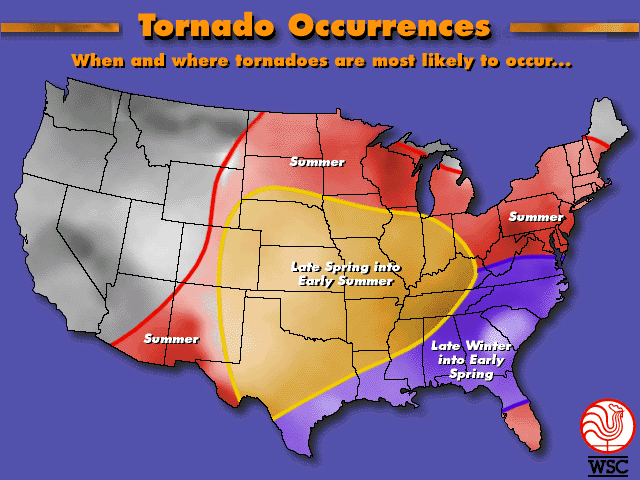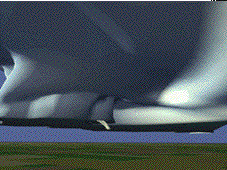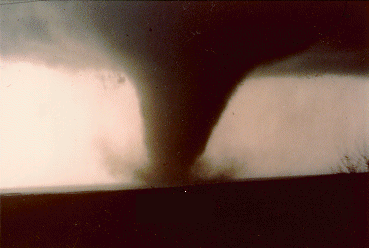Tornadoes are one of the weathers most deadly and fascinating forces. Even though they are often limited by size (not being more than one kilometer wide at most) they leave vast areas of destruction and death behind them. They are also called twisters or cyclones.
Tornadoes are characterized by violent winds that swirl in a counterclockwise direction north of the equator and clockwise south of the equator. Most people recognize them as a towering black funnel extending downward from the base of a large cumulonimbus cloud. It rotates at speeds up to three hundred miles per hour (480 kpm) or in some rare cases, even faster. In the center of the tornado, the air pressure is very low in comparison to surrounding air pressure.

The speed of the wind is the primary cause of deaths and destruction of property. Many people are killed by flying objects and debris (missiles). The funnel-shaped cloud travels in a skip like movement, and usually never lasts for more than a couple of minutes in any one given place. It is because of this skip movement that the tornado leaves some areas wrecked while others a few yards away almost untouched.
Certain parts of the world (ie. Australia, the Midwestern and Southern US) are more prone to have tornadoes. They also occur more frequently in the spring and summer months. Tornadoes usually occur as part of a severe thunderstorm and often come in advance of cold fronts, however, they can also occur (although less frequently) ahead of warm fronts, and even behind cold fronts.
The greatest killer tornado in the United States occurred during the year 1925 in Indiana, Illinois, and Missouri. It was the fastest and largest one ever recorded, with a destructive path two hundred and twenty miles long and one mile wide, and traveled at a speed of sixty miles per hour. It killed six hundred ninety-five people and injured over two thousand.
How Tornadoes are Formed
Table of Contents
At this point in time, the formation of tornadoes is not fully understood by scientists. They usually form in a giant rotating thunderstorm called a supercell. Supercells form when cold polar air meets warm tropical air. The result is a great instability caused by the rising warm air. A squall line, or narrow zone of cumulonimbus clouds forms, giving life to the tornadoes. Lightning flashes and heavy rains and hail begin to fall. Soon after, the easiest recognizable part of the tornado, the funnel, seems to descend from the base of the cloud. In actuality, it does not, but rather the pressure within the cloud drops due to the increasing wind speeds. This is known as Bernoulli’s principle. As the pressure drops, it causes moisture in the air to condense. This action continues down the spiral, giving the impression that the funnel is descending from the cloud base. In addition to the visible funnel, there is also a hissing sound, which turns into a loud roar when the tornado touches the earth.
 Many people believe that there is no tornado unless there is a visible funnel cloud. However, this is not true, for ‘invisible’ tornadoes can exist. Its the same thing as a normal tornado, but the funnel cloud does not descend to the ground. The latter situation is extremely rare. This is a simulation of how a tornado forms:
Many people believe that there is no tornado unless there is a visible funnel cloud. However, this is not true, for ‘invisible’ tornadoes can exist. Its the same thing as a normal tornado, but the funnel cloud does not descend to the ground. The latter situation is extremely rare. This is a simulation of how a tornado forms:
Once the tornado reaches the ground, it starts to up debris around it. This can actually change the color of the tornado because some dirt in the southern states is actually a deep shade of red.
Classification of Tornadoes
Tornadoes are classified in the United States on a scale called the Fujita-Pearson Scale, named after Professor Fujita of the University of Chicago and Dr. Allen Pearson, director of the National Severe Storm Forcast Center. There are seven levels on the Fujita scale, from zero to six (six being the strongest). Remember that the size of the tornado does not necessarily show how destructive it is. Small tornadoes can be more devastating than large ones.
The Fujita Scale
| F Number | Wind Speeds (mph) | Intensity Description | Type of Damage Capable |
| 0 | 40 – 72 | Gale Tornado | Minor structural damage. Tree branches break off, and small trees are uprooted. Damages large signs also |
| 1 | 73 – 112 | Moderate Tornado | Hurricane wind speed. Roof surface ripped off houses, and mobile homes are overturned. Cars are pushed off the road and attached garages might be destroyed. |
| 2 | 113-157 | Significant Tornado | Extensive damage. Roofs tore off frame houses. Mobile homes destroyed. Trains’ boxcars turned over. Large trees are torn from the ground and snapped. Light objects become deadly missiles. |
| 3 | 158 – 206 | Severe Tornado | Roofs of well-built houses are ripped off. Numerous trees ripped out of the earth. Trains are overturned. |
| 4 | 207 – 260 | Devastating Tornado | Well-built homes are totally destroyed. Newly built homes are thrown considerable distances. Cars are thrown and other large objects become missiles. |
| 5 | 261 – 318 | Incredible Tornado | Well built homes are torn out of the ground and thrown great distances. Trees grow debarked, and car size missiles fly up to one hundred meters. Steel reinforced concrete structures are badly damaged. |
| 6 | 319 – 379 | Inconceivable Tornado | Winds at these speeds are highly unlikely, but if a tornado this big did occur, the wreckage would be so great it would be unidentifiable. Everything would be destroyed. |
Forecasts
Perhaps one of the best means of safety is always being prepared. This involves keeping yourself informed about changing weather conditions. The National Weather Service uses specific terms that denote the severity of a pending storm. The same words are then used by the meteorologists.

Satellites carry cameras which beam pictures back to earth about cloud and moisture formation above, and snow and ice below to observation stations on the ground. The meteorologist collects this valuable information, analyses and maps it, and uses it to inform the public about what type of weather to expect. Unfortunately, if a tornado is going to occur, meteorologists usually can only alert us about eighteen to thirty-six hours in advance (short-range forecast). Radar is also used to track severe storms. One type of detector, called Doppler, is beneficial because it can indicate the location and possible path the tornado will take as well as the wind speed.
Generally speaking, when weather forecasts are issued, they contain information on the type of weather (i.e. is it sunny, cold, or boating or farming conditions). However, when an advisory bulletin is issued, there are two essential terms used that we should all be familiar with. These are “watch,” and “warning” and are valuable in preparing us for a pending storm. A watch, when it applies to a tornado, means that the conditions are right and the odds are good for one to form. A warning means that a tornado is in progress and that you must get into shelter immediately.
Ten Most Devastating Tornadoes
These are the top ten most devastating tornadoes to date. If you look at the years, most occurred in the late 1800’s/early 1900s. This is because of the lack of warning systems to protect the citizens of the US. Today, there may be severe property damage, but the death toll is not as heavy, due to advanced forecasting and well-organized evacuations
| Rank # | Dead | Injured | Scale # | Location | Date | Time |
| 1 | 695 | 2027 | F5 | Murphysboro MO/Gorham IL/De Soto IN | March 18, 1925 | 1:01 PM |
| 2 | 317 | 109 | Unknown | Natchez MS | May 7, 1840 | 1:45 PM |
| 3 | 255 | 1000 | F4 | St. Louis IL | May 27, 1896 | 6:30 PM |
| 4 | 216 | 700 | F5 | Tupelo MS | April 5, 1936 | 8:55 PM |
| 5 | 203 | 1600 | F4 | Gainesville GA | April 6, 1936 | 8:27 AM |
| 6 | 181 | 970 | F5 | Glazier TX/Higgins OK/Woodward KS | April 9, 1947 | 6:05 PM |
| 7 | 143 | 770 | F4 | Amite LA/Pine LA/Purvis MS | April 24, 1908 | 11:45 AM |
| 8 | 117 | 200 | F5 | New Richmond WI | June 12, 1899 | 5:40 PM |
| 9 | 115 | 844 | F5 | Flint MI | June 8, 1953 | 8:30 PM |
| 10 | 114 | 597 | F5 | Waco TX | May 11, 1953 | 4:10 PM |
Tornado myths
As we are in the midst of the peak season for tornadoes in the southern half of the United States (the peak season for the southern states is March-May and the late spring-early summer in the northern states), I thought a good article would be a discussion of tornado myths.
Myth: Rivers, lakes, and mountains are safe from tornadoes.
Truth: No place is safe from tornadoes, Yellowstone National Park was hit by a tornado that did extensive damage to a 10,000-foot mountain
Myth: Highway overpasses are good shelters from tornadoes
Truth: Absolutely not. Overpasses can be extremely dangerous because there is little protection from flying debris. Plus, in the event of the direct hit, you would most likely be blown out of the overpass shelter and would in the midst of the deadly wind of debris moving 100-200 miles per hour.
Myth: You should also take cover in the southwest portion of your basement.
Truth: You are far better off hiding in a place where there is a sturdy table or stairwell, no matter what part of the basement of the house. In general, hiding in a basement will protect you from injury in any situation. This myth came into being because tornadoes often approach from the southwest and it was assumed that storm would force debris towards the northeast and away from you. Actually, the southwest corner is often the least safe because most tornadoes only shift houses off their foundations in a northeast direction. The unsupported part of the house then might collapse in the southwest part of the basement where you thought it was safest! The few deaths that have occurred in basements were caused by collapse portions of the house that were ripped from the foundations, not debris from the wind which the myth was based on. As mentioned above, location doesn’t matter all that much if you can hide under the stairwell or a sturdy table.
Myth: This is by far the most common myth: opening your windows will lessen the damage. If you can equalize the pressure between the interior and vortex of the tornado, your home won’t “explode”.
Truth: Even the most powerful storms have a pressure drop that a typical building can vent in mere seconds. However, your home is already destroyed by the time the maximum pressure drop reaches you. There is also zero evidence that opening windows strategically to allow wind to vent through the house will do any good. Bottom line: get to the basement and forget the windows. If you have a powerful tornado bearing down on your house, nothing will prevent catastrophic damage but being in the basement will save your life.
—
Because it never hurts to refresh your memory, here are tornado safety guidelines from the National Weather Service:
- In a home or building, move to a pre-designated shelter, such as a basement. If an underground shelter is not available, move to a small interior room or hallway on the lowest floor and get under a sturdy piece of furniture. Put as many walls as possible between you and the outside.
- Stay away from windows.
- Get out of automobiles. Do not try to outrun a tornado in your car; instead, leave it immediately for safe shelter. If caught outside or in a vehicle, lie flat in a nearby ditch or depression and cover your head with your hands.
- Be aware of flying debris. Flying debris from tornadoes causes most fatalities and injuries.
- Mobile homes, even if tied down, offer little protection from tornadoes. You should leave a mobile home and go to the lowest floor of a sturdy nearby building or a storm shelter.
- Finally, if you live in a rural area that doesn’t have tornado sirens – you should definitely get a NOAA weather radio with an alarm tone and battery backup. They are sold in many stores and some even have crank devices that allow you to charge cell phone batteries during long-term power outages (this is especially useful if you live in a hurricane-prone area).
Sources:
1. “Thunderstorms, Tornadoes, Lightning” – Weather Safety Guide from The National Weather Service – PDF file
2. “Overpasses are tornado death traps”, by Chris Cappella, USATODAY.com
3. Myths and Misconceptions about Tornadoes, The Tornado Project – not a rock-solid source like a newspaper or the National Weather Service but from what I can tell, the author(s) have done their homework as they mention interviews with structural engineers so I think it’s a credible source.
